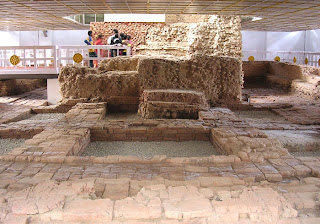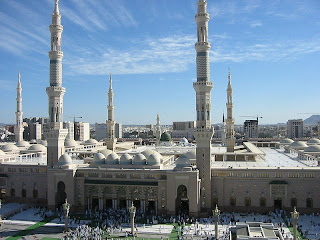Lumbini is the traditional birthplace of Gautama Buddha, the founder of Buddhism, who was born in the 7th or 6th century BC.
According to Buddhist tradition, Maya Devi (or Mayadevi) gave birth to the Buddha on her way to her parent's home in Devadaha in the month of May in the year 642 BC. Feeling the onset of labor pains, she grabbed hold of the branches of a shade tree and gave birth to Siddharta Gautama, the future Buddha. The Buddha is said to have announced, "This is my final rebirth" as he entered the world. Buddhist tradition also has it that he walked immediately after his birth and took seven steps, under each of which a lotus flower bloomed.
Lumbini, the birth place of Lord Buddha, is situated about 22 km. from Bhairahawa (Siddharthanagar), below the Churia range, 24 km. south from the foothills of the Himalayas, on the western bank of Telar river in Rupandehi district of Lumbini zone in Nepal. It is about 300 km. west of capital city Kathmandu. Kapilvastu, Rupandehi and Nawalparasi Terai districts of Lumbini Zone are around Lumbini, the birth place of Lord Buddha, which are fertile and densely populated.It is about 34 km. from Naugarh Railway Station on the North-Eastern Railway of India. Buddha, Known as the Lord of Asia, was born in Lumbini during the full moon day in the month of Baisakh in 623 BC. He was born under a sal (Shorea robusta) tree when Mayadevi was going to her maternal town on the occasion of delivery.
Suttanipata has mentioned the earliest description of the birth of Buddha in Lumbini. After the birth of Buddha he took seven steps towards north and, looking in all directions, he declared that "I am the foremost of all creatures to cross the riddle of the ocean of the existence, this is my last birth and here after, I will not be born again". The site is spelt as Rummindei or Rupandei (beautiful lady), the perverted form of Rupa devi, the queen Anjana of the king of Devadaha which was situated to the east of Kapilvastu in ancient time. The site is called Lun- min and La-Fa-Ni by the Chinese pilgrims Fa- Hien and Hiuen- Tsiang respectively. In course of exploration of the ancient Buddhist sites General Cunningham has mentioned La-Fa-Ni is Sanskrit Lavani, a beautiful lady. In Buddhist literature it is known as Pradimoksa vana blessed with various trees and flowers, which is compared to the Chittalata grove of Indra's paradise in heaven. The earliest Pali text Suttanipata has mentioned that, "The wisdom- child, that Jewel so precious, which can not be matched, has been born at Lumbini, in the Sakya land for well being and joy in the world of men". A Muslim historian of India named Abul Fazal has called Mokta. It is also known as Paderiya (Parariya) where the Asokan pillar is located in the Nepalese Terai. The name of the site is spelt Lumminigame and Lumbini Vana in the Asokan pillar Edict still standing at the same place. Mukherji has also mentioned the name Rummin-dei in his report. In the Magadhi language, being used in the north-eastern pillar edicts in India and Nepal, 'la' is invariable substituted for 'ra'. The location of Lumbini is pointed out in the Buddhist literature, as well as, in the records of the Chinese pilgrims who visited India in the fifth and seventh centuries AD. As mentioned in Jataka story this sal garden was in joint possession of the Sakayas and Koliyas during the life time of Buddha. The Mahavamsa, a Ceylones chronicle, and Nidana katha have also located it between Kapilvastu and Devadaha. The sal garden was the place of recreation during the reign of the Sakayas and Koliyas.
Buddha charita of Asvaghosa describes Lumbini as "gay like the garden of caitra ratha with trees of every kind. According to Fa- Hien it is located about 50 li east of Kapilvastu. Hiuen- Tsiang had also pointed out that it was about 80 or 90 li.(21.729 or 24.445 km.) north-east of arrow-well. It was linked through popular ‘Uttara path' to Kapilvastu, Ramagrama and other important cities during the Buddhist period. The present location of Lumbini, the exact birth place of Lord Buddha, is absolutely clear.
In 249 BC, the Buddhist convert Emperor Ashoka visited Lumbini and constructed four stupas and a stone pillar. Ashoka's Pillar bears an inscription that translates as: "King Piyadasi (Ashoka), beloved of devas, in the 20 year of the coronation, himself made a royal visit, Buddha Sakyamuni having been born here, a stone railing was built and a stone pillar erected to the Bhagavan ["blessed one"] having been born here. Lumbini village was taxed reduced and entitled to the eight part (only)".
Monasteries and temples were built at Lumbini until the 9th century, but Buddhism declined in the area after the arrival of Islam and later Hinduism. All that remained was a sculpture, revered by local women as a fertility symbol. The garden of the Buddha's birth was lost for a thousand years.
The site was rediscovered in 1895, when a German archaeologist came upon Ashoka's Pillar, identified by its inscription. Records made by the Chinese pilgrim Fa Xian were also used in the process of identifying this religiously acclaimed site. Lumbini was designated a UNESCO World Heritage Site in 1997.
Lumbini lies in the foothills of the Himalayas in Nepal. The site is a large garden with a grove of pipal trees. The area around Lumbini is entirely Hindu, but many Buddhist temples and shrines from various nations are scattered around the holy site itself.
The most important temple at Lumbini is the Maya Devi Temple, which enshrines the traditional site of the Buddha's birth. The current temple stands on the site of earlier temples and stupas, including the stupa built by Ashoka.
The modern temple consists mainly of simple white building that protects ancient ruins, with the exact spot of the Buddha's birth identified. The delicate sandstone sculptures discovered here are now in the National Musuem inKathmandu.
Atop the temple is a small square tower of the type seen in Kathmandu, with Buddha eyes on each side and a golden pinnacle on top.
On the south side of the temple is a sacred pool (see top photo), where it is said Maya Devi bathed before giving birth, and where the newborn Buddha was washed by two dragons.
The Maha Devi temple is surrounded by the brick foundations of ancient temples and monasteries. All around Lumbini, long lines of colorful prayer flagsare strung between trees. They carry prayers and mantras heavenward as they flap on the breeze.
The other main sight of interest at Lumbini is Ashoka's Pillar, near the temple. It is protected by a small fence, which is decorated with prayer flags and banners from the faithful. Around the courtyard containing the pillar are bowls for incense sticks, and there is room to sit in front of the pillar for contemplation
Lumbini is in west-central Nepal near the Indian border. It is not terribly easy to get to, and the site does not receive a large amount of visitors. Most pilgrims to Lumbini come from Southeast Asia, Japan and Tibet, but westerners come regularly as well.





























































